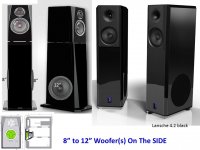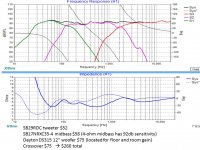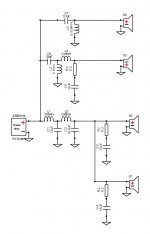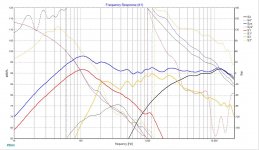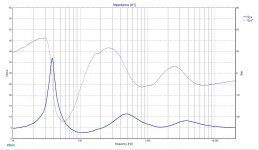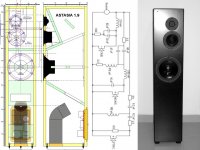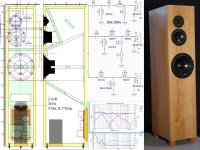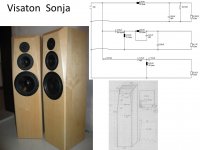Hello ladies and gentlemen!
Long time lurker first time poster so a little background before the technicals. I've been perusing through here for ages and finally think I'm ready to step into the world of designing my own DIY. I'm not a total beginner having built a set of Aviatrix and a set of Volt 6 before, but I've never designed my own. I'd post pictures but the aviatrix were given to a friend as a house warming gift, though haven't heard any complaints (other than about my colour choice of blue ).
).
Not too long ago I bought a house and am slowly working on the living room. I've got a central wall about 8'x15'. I'll be adding shelves on the lower sides, a giant art piece up in the middle (looking at roughly 4'x8' custom print on fabric), and in the middle of the wall I want to put my record player and what I'm hoping to name The Qualias.
In case you haven't figured out I want to prioritize form over function, but still have decent sounding speakers for my records. I have a budget of roughly $500 for the pair.
Since I was already familiar with Curt Campbell's work I was strongly considering building the Uluwatu he designed, but they don't *quite* do it for me so now I'm here. I really like the 2.5 way concept, I like the line arrays I've seen, so the Uluwatu seems like a nice blend, a 2.5 way mini-array.
My current thought process is taking the Uluwatu as a base design, and making it my own. To do so I'm thinking (per speaker except for miniDSP):
6xps95-8
1xpeerless H26TG45-06
1xminiDSP 2x4 kit with pot
1xInductor(value TBD)
1xTPA3116D2 amp
(Estimating ~$260 before wood)
My thinking is I can wire similar to the Uluwatu (two in series, paralleled with two other series pairs to give me nominal 6 Ohms) and then use a miniDSP for crossover and EQ between the six ps95-8 and the tweeter, then power it all with the TPA3116D2. The inductor is to go in series with the last two pairs to roll off the mids making it a 0.5 speaker since I couldn't see a way to do that with the miniDSP without buying a bigger one. This is how the Uluwatu does it.
I'm drawn towards the ps95-8 for a couple reasons: its cheap(ish), I love the look more than the cheaper TC9FD (that copper phase plug), its still highly regarded from what I see, it should go high enough to cross to a tweeter, and it looks to go low enough to integrate with a sub (should I even want one).
I know the ps95-8 is a fullrange speaker, but I'm not a fan of its response plot past 4 kHz and I don't want to do a full line array (nor a one speaker tower), it seems like this 2.5 way array (is that even the right term?) is the happy medium I'm after.
My rough estimate is that the 6 ps95-8 would give me roughly 91 db 1w/1m and tried to choose a tweeter that could keep up, and I know I like silk domes so the peerless seemed to fit. Plus the off axis response seemed decent enough for when I'm in the dining room or kitchen (roughly 30 to 45 degrees off axis, I know I can't get perfect response in the upper frequencies). Is my sensitivity guess close? I'd likely need to pad the peerless then, I'm guessing the miniDSP can do that also correct? I started with 85 db 1w/1m for a series pair of ps95-8, then added +6 for the other two series pairs (+3 each). It also doesn't hurt I like the looks of the peerless tweeter. On a similar note, I'm estimating 60 Watt power handling. 6*10 since each ps95-8 has a 10 watt RMS and would see a sixth of the voltage no? 100 watt RMS for peerless tweeter so no issue there, seem reasonable?
I'm thinking I'll cross at 4 kHz (4 times the Fs of the peerless so well within when it should cross, outside the 3kHz I'vee seen for the sensitive range of human hearing, and where I start to not like the look of the ps95-8 plots). Then start the roll off for the 0.5 set at about 1500 Hz (6" internal width, +1.5" for wood sides to get external width, gives 7.5" which is roughly 1500 kHz, my guess for start of baffle step). Plus, if I can get the ps95-8's roughly 4 inches center to center (outer diameter of driver is 3.87" so seems totally doable) that would mean comb filtering would start at ~3.5 kHz correct? Crossing to a tweeter there would ameliorate that would it not? This begs the question, should I just cross at 3.5 kHz?
I played around with some modelling in WinISD and liked the look of the suggested 0.11ft^3 vented box tuned to 68 Hz. So for dimensions of final speaker I was looking at 6"x4.5"x47" (WxDxH) internal, when adjusting for roughly 3 in^3 speaker displacement (times 6 for the lot of them) I got .68 ft^3. Not sure how to gauge the effect of stuffing.
Three last things if it helps you judge me. I'm single with no prospects so no WAF any time soon, (though I think The Qualia as they stand now could look classy with a nice Rosewood Burl veneer). I'm thinking this picture for the art (it tested well with my friends). These speakers will need to play everything from The Fugees all the way to Unleash The Archers and beyond, I listen to everything.
My questions for you guys:
Am I even in the realm of reasonable?
Do my chosen crossover and rolloff points look workable?
Am I missing something?
Am I crazy?
Is there a speaker that looks similar to the ps95-8 that would work better?
Will my chosen tweeter work with the ps95-8?
Rounding the edges of the baffle will only smooth the baffle step towards the spherical ideal, not change its frequency right?
With the miniDSP would I still need a resistor on the tweeter and resistor+capacitor on the woofers to smooth impedance or is that only needed with a passive crossover?
Should I open a bottle of my home made mead tonight?
Thank you in advance to anyone who not only got through all that but also answers!
Long time lurker first time poster so a little background before the technicals. I've been perusing through here for ages and finally think I'm ready to step into the world of designing my own DIY. I'm not a total beginner having built a set of Aviatrix and a set of Volt 6 before, but I've never designed my own. I'd post pictures but the aviatrix were given to a friend as a house warming gift, though haven't heard any complaints (other than about my colour choice of blue
Not too long ago I bought a house and am slowly working on the living room. I've got a central wall about 8'x15'. I'll be adding shelves on the lower sides, a giant art piece up in the middle (looking at roughly 4'x8' custom print on fabric), and in the middle of the wall I want to put my record player and what I'm hoping to name The Qualias.
In case you haven't figured out I want to prioritize form over function, but still have decent sounding speakers for my records. I have a budget of roughly $500 for the pair.
Since I was already familiar with Curt Campbell's work I was strongly considering building the Uluwatu he designed, but they don't *quite* do it for me so now I'm here. I really like the 2.5 way concept, I like the line arrays I've seen, so the Uluwatu seems like a nice blend, a 2.5 way mini-array.
My current thought process is taking the Uluwatu as a base design, and making it my own. To do so I'm thinking (per speaker except for miniDSP):
6xps95-8
1xpeerless H26TG45-06
1xminiDSP 2x4 kit with pot
1xInductor(value TBD)
1xTPA3116D2 amp
(Estimating ~$260 before wood)
My thinking is I can wire similar to the Uluwatu (two in series, paralleled with two other series pairs to give me nominal 6 Ohms) and then use a miniDSP for crossover and EQ between the six ps95-8 and the tweeter, then power it all with the TPA3116D2. The inductor is to go in series with the last two pairs to roll off the mids making it a 0.5 speaker since I couldn't see a way to do that with the miniDSP without buying a bigger one. This is how the Uluwatu does it.
I'm drawn towards the ps95-8 for a couple reasons: its cheap(ish), I love the look more than the cheaper TC9FD (that copper phase plug), its still highly regarded from what I see, it should go high enough to cross to a tweeter, and it looks to go low enough to integrate with a sub (should I even want one).
I know the ps95-8 is a fullrange speaker, but I'm not a fan of its response plot past 4 kHz and I don't want to do a full line array (nor a one speaker tower), it seems like this 2.5 way array (is that even the right term?) is the happy medium I'm after.
My rough estimate is that the 6 ps95-8 would give me roughly 91 db 1w/1m and tried to choose a tweeter that could keep up, and I know I like silk domes so the peerless seemed to fit. Plus the off axis response seemed decent enough for when I'm in the dining room or kitchen (roughly 30 to 45 degrees off axis, I know I can't get perfect response in the upper frequencies). Is my sensitivity guess close? I'd likely need to pad the peerless then, I'm guessing the miniDSP can do that also correct? I started with 85 db 1w/1m for a series pair of ps95-8, then added +6 for the other two series pairs (+3 each). It also doesn't hurt I like the looks of the peerless tweeter. On a similar note, I'm estimating 60 Watt power handling. 6*10 since each ps95-8 has a 10 watt RMS and would see a sixth of the voltage no? 100 watt RMS for peerless tweeter so no issue there, seem reasonable?
I'm thinking I'll cross at 4 kHz (4 times the Fs of the peerless so well within when it should cross, outside the 3kHz I'vee seen for the sensitive range of human hearing, and where I start to not like the look of the ps95-8 plots). Then start the roll off for the 0.5 set at about 1500 Hz (6" internal width, +1.5" for wood sides to get external width, gives 7.5" which is roughly 1500 kHz, my guess for start of baffle step). Plus, if I can get the ps95-8's roughly 4 inches center to center (outer diameter of driver is 3.87" so seems totally doable) that would mean comb filtering would start at ~3.5 kHz correct? Crossing to a tweeter there would ameliorate that would it not? This begs the question, should I just cross at 3.5 kHz?
I played around with some modelling in WinISD and liked the look of the suggested 0.11ft^3 vented box tuned to 68 Hz. So for dimensions of final speaker I was looking at 6"x4.5"x47" (WxDxH) internal, when adjusting for roughly 3 in^3 speaker displacement (times 6 for the lot of them) I got .68 ft^3. Not sure how to gauge the effect of stuffing.
Three last things if it helps you judge me. I'm single with no prospects so no WAF any time soon, (though I think The Qualia as they stand now could look classy with a nice Rosewood Burl veneer). I'm thinking this picture for the art (it tested well with my friends). These speakers will need to play everything from The Fugees all the way to Unleash The Archers and beyond, I listen to everything.
My questions for you guys:
Am I even in the realm of reasonable?
Do my chosen crossover and rolloff points look workable?
Am I missing something?
Am I crazy?
Is there a speaker that looks similar to the ps95-8 that would work better?
Will my chosen tweeter work with the ps95-8?
Rounding the edges of the baffle will only smooth the baffle step towards the spherical ideal, not change its frequency right?
With the miniDSP would I still need a resistor on the tweeter and resistor+capacitor on the woofers to smooth impedance or is that only needed with a passive crossover?
Should I open a bottle of my home made mead tonight?
Thank you in advance to anyone who not only got through all that but also answers!
In case you haven't figured out I want to prioritize form over function, but still have decent sounding speakers for my records. I have a budget of roughly Estimating ~$260 before wood.
A narrow TM top with the woofer(s) on the side can deliver the form you described, with sound quality proven by designs like Jeff Bagby's 3-way Kairos: A coherent sealed TM with a side woofer. One quality driver for each frequency range. One pair of Side-Side counter-force 8" woofers would allow a 10" deep cabinet. A single 12" side woofer often creates the cabinet depth required for good rear wall reflection gain, and also puts the drivers in front of bookshelves. Using 4-ohm drivers can increase sensitivity.
SB29RDC tweeter $52
SB17NRXC35-4 midbass $58 (4-ohm midbass has 92db sensitivity)
Dayton DS315 12" woofer $75 (located for floor and room gain)
Crossover $75
total around $260
(Do you already own a mini-DSP and multiple amplifiers? )
Attachments
A narrow TM top with the woofer(s) on the side can deliver the form you described,
Sorry if this sounds snarky, not sure how else to word it, but I'm guessing by form here you're talking general dimensions and sound? I talked about line arrays and pointed at a mmtmmmm 2.5 way. Small TM with a woofer isn't similar form. I like the look of the multi driver systems. Ala boston acoustics m350, The Two Towers, and the previously mentioned Uluwatu. I understand a simple but well done 2 or 3 way will sound better, but not quite what I'm looking at doing.
with sound quality proven by designs like Jeff Bagby's 3-way Kairos
Is there a list of his speakers somewhere? I've looked before but only find them piecemeal. I'm aware of his speaker design tools, and some builds like the 88 special.
A coherent sealed TM with a side woofer. One quality driver for each frequency range. One pair of Side-Side counter-force 8" woofers would allow a 10" deep cabinet. A single 12" side woofer often creates the cabinet depth required for good rear wall reflection gain, and also puts the drivers in front of bookshelves. Using 4-ohm drivers can increase sensitivity.
SB29RDC tweeter $52
SB17NRXC35-4 midbass $58 (4-ohm midbass has 92db sensitivity)
Dayton DS315 12" woofer $75 (located for floor and room gain)
Crossover $75
total around $260
I'm kind of trying to get away for the same old same old. Everyone has the flat black midbass speaker in a 2-way with some woofers. Kind of looking for something...different. Which is why I started looking at the ps95-8. Otherwise I could have gone with the TC9FD everyone loves over the in fullrange forum section and do another line array.
I don't, but I've been enjoying the speaker hobby so far so figured now's a great time to get some versatile tools. Plus the $500 budget is more a suggestion than a brick wall.(Do you already own a mini-DSP and multiple amplifiers? )
Curt Campbell designed the following ( which I assume you know having already assembled some Volt-6's).
Fusion-4
Adding another pair of drivers ( of the same make or similar 4" ) for dedicated .5 bass ( frequency limited by an appropriately sized coil ) would achieve what you're after.
The added .5 bass drivers could be housed within their own enclosure ( allowing you to buy the DIYSG flat-pack for your plus-sized Quad-6 ) .
The kits 1"phenolic-domed driver could be swapped out at a later date ( when you have a bit more design experience ).

Fusion-4
An externally hosted image should be here but it was not working when we last tested it.
Adding another pair of drivers ( of the same make or similar 4" ) for dedicated .5 bass ( frequency limited by an appropriately sized coil ) would achieve what you're after.
The added .5 bass drivers could be housed within their own enclosure ( allowing you to buy the DIYSG flat-pack for your plus-sized Quad-6 ) .
The kits 1"phenolic-domed driver could be swapped out at a later date ( when you have a bit more design experience ).
Last edited:
WW-Coaxial-WW
6.5" woofer
6.5" woofer
Volt-6 coaxial sealed, up to 250Hz
6.5" woofer
6.5" woofer
This ~34" long 5-driver arrangement would better approximate a point source, with fewer irregular room effects due to the symmetric floor-ceiling short line array interaction.
200Hz = 68" wavelength ==> 17" quarter wavelength - no lobing == 34" half wavelength - modest lobing
250Hz = 54" wavelength ==> 14" quarter wavelength - no lobing == 28" half wavelength - modest lobing
Less snarky?
6.5" woofer
6.5" woofer
Volt-6 coaxial sealed, up to 250Hz
6.5" woofer
6.5" woofer
This ~34" long 5-driver arrangement would better approximate a point source, with fewer irregular room effects due to the symmetric floor-ceiling short line array interaction.
200Hz = 68" wavelength ==> 17" quarter wavelength - no lobing == 34" half wavelength - modest lobing
250Hz = 54" wavelength ==> 14" quarter wavelength - no lobing == 28" half wavelength - modest lobing
Less snarky?
Thought I'd respond to some of your concerns ( plus add a couple of my own ).

- Am I even in the realm of reasonable? >> YES
- Do my chosen crossover and rolloff points look workable? >>2K seems more reasonable given the ps95ès uneven reponse above 2K.
- Am I missing something? >> I'd say one thing you are overlooking is the total Sd of the array. Total Sd ( cone area ) will help govern how much bass the array can produce. Your 6 element array has a very small Sd figure > I'd look to doubling it.
- Am I crazy? >> NO
- Is there a speaker that looks similar to the ps95-8 that would work better? >> Don't know
- Will my chosen tweeter work with the ps95-8? >> YES, quite well actually!
- Rounding the edges of the baffle will only smooth the baffle step towards the spherical ideal, not change its frequency right? >> ???
- With the miniDSP would I still need a resistor on the tweeter and resistor+capacitor on the woofers to smooth impedance or is that only needed with a passive crossover? >> NO, you won't need a zobel on the woofer leg of this network, though I believe an LCR notch across the woofers highish resonance frequency will be off some benefit
- Should I open a bottle of my home made mead tonight? >> SURE!
WW-Coaxial-WW
6.5" woofer
6.5" woofer
Volt-6 coaxial sealed, up to 250Hz
6.5" woofer
6.5" woofer
This ~34" long 5-driver arrangement would better approximate a point source, with fewer irregular room effects due to the symmetric floor-ceiling short line array interaction.
200Hz = 68" wavelength ==> 17" quarter wavelength - no lobing == 34" half wavelength - modest lobing
250Hz = 54" wavelength ==> 14" quarter wavelength - no lobing == 28" half wavelength - modest lobing
Less snarky?
By "up to" 250 Hz did you mean the volt 6 would handle 250Hz-20kHz?

This is an XSim prediction using Dayton provided .frd & .zma files ( as well as "traced" .frd & .zma files for the Peerless tweeter )

Ooh lala. How did I miss that HiVi before? I'm liking the looks of that numbers wise and your fiction. I think we might have a winner!
I'll play more with sims and such over the next day or two and see where I get.
I'm also probably going to play around simming linesource's suggestion using that hivi.
Take 2
Well, I'm back. I decided that instead of completely ignoring advice and doing something stupid I'd take more time to read, learn, and reassess. I've now read a few books, read many more forum posts, and am ready to tackle this again I think.
Here's where I'm at now: TMWW in a Double Chamber Reflex enclosure
I like the look of some of the boxes I've seen, and the ability to give a little boost to the midbass seems nice. For drivers I'm looking at
Hivi RT1C-A Tweeter
Tang Band W3-881SJF Mid
Hivi M6N Woofer
These all seem to cover great where the other drivers fail. M6N looks to have smooth bass, the tang band looks to have enough extension on both ends to tie the woofer and tweeter together, and the tweeter looks to have a smooth, low distortion high end.
I've attached my first pass at a passive crossover. It doesn't account for adding the ports or baffle step or anything like that, not optimized for phase either and I know few amplifiers that enjoy a 3 Ohm load which this hits at the bottom. I'm still strongly considering going active using Jriver or some other convolver and the Minidsp Udac-8. I'd love to learn though so any advice on the crossover is definitely appreciated.
I used a 4'th order crossover on the woofer because it starts distorting quickly after 500 hz. The mid and tweeter cross at 3kHz. The mid looks like it could easily handle a higher crossover point though if that's too low for the tweeter.
The one thing I'm unsure of about this design is the mid seems to not be sensitive enough too keep up with the other drivers. 88dB vs 92 db for woofers (89dB +3dB for two drivers), and 94 dB for tweeter. Should I use a second mid above the tweeter? Or WMTMW?
Overall thoughts on the design so far? How does this design look like it might do off axis? I tried to also pick drivers that took over when the larger one started beaming, so as far as I can tell off-axis response should be decent.
I'm getting to the point where I think I might need to just buy the drivers, and if this design doesn't pan out I'll use them in something else. Only so much reading one can do before acting.
Well, I'm back. I decided that instead of completely ignoring advice and doing something stupid I'd take more time to read, learn, and reassess. I've now read a few books, read many more forum posts, and am ready to tackle this again I think.
Here's where I'm at now: TMWW in a Double Chamber Reflex enclosure
I like the look of some of the boxes I've seen, and the ability to give a little boost to the midbass seems nice. For drivers I'm looking at
Hivi RT1C-A Tweeter
Tang Band W3-881SJF Mid
Hivi M6N Woofer
These all seem to cover great where the other drivers fail. M6N looks to have smooth bass, the tang band looks to have enough extension on both ends to tie the woofer and tweeter together, and the tweeter looks to have a smooth, low distortion high end.
I've attached my first pass at a passive crossover. It doesn't account for adding the ports or baffle step or anything like that, not optimized for phase either and I know few amplifiers that enjoy a 3 Ohm load which this hits at the bottom. I'm still strongly considering going active using Jriver or some other convolver and the Minidsp Udac-8. I'd love to learn though so any advice on the crossover is definitely appreciated.
I used a 4'th order crossover on the woofer because it starts distorting quickly after 500 hz. The mid and tweeter cross at 3kHz. The mid looks like it could easily handle a higher crossover point though if that's too low for the tweeter.
The one thing I'm unsure of about this design is the mid seems to not be sensitive enough too keep up with the other drivers. 88dB vs 92 db for woofers (89dB +3dB for two drivers), and 94 dB for tweeter. Should I use a second mid above the tweeter? Or WMTMW?
Overall thoughts on the design so far? How does this design look like it might do off axis? I tried to also pick drivers that took over when the larger one started beaming, so as far as I can tell off-axis response should be decent.
I'm getting to the point where I think I might need to just buy the drivers, and if this design doesn't pan out I'll use them in something else. Only so much reading one can do before acting.
Attachments
You'll be lucky to get much of anything outta that tweeter below 4.5k, as it drops like a rock, which is not what you show in your sim. That said- the 3" will reach high enough, and also low enough to meet the woofer at about 450Hz. You will have to adjust levels to match tonal balance, and realize that BSC involves reducing ALL above the baffle-step freq to -6dB from the woofer's sensitivity. If you have an 86dB woofer, your system sensitivity will be about 80dB with full BSC. This means speculatively that the mid will be padded about 7dB and the tweeter about 15dB.
Later,
Wolf
Later,
Wolf
Seems you can cross the W3 at about 8k and let tweeter do the rest. Since the W3 does not do much above 10k. You can see it in the reviews of the W3 on PE.
I do not know why you selected this particular tweeter, there are better candidates, Wolf_Teeth makes a good point.
I do not know why you selected this particular tweeter, there are better candidates, Wolf_Teeth makes a good point.
Last edited:
It sounds like overall I'm onto something better here and that these drivers, although not the greatest all around, show some potential and I might be on the right track.
Its what fit my design goals. I'm balancing looks, cost, and performance. I started this second design by looking for a good mid I like, then adding bass, and then finding a tweeter to clean up the top end. I'm going with a gold/brass/yellow driver thing for design aesthetics, and so after narrowing tweeters to my acceptable price, this one fit the looks I was after and also could cover the high end where the W3 drops out.
I understand this isn't optimal, but I'm still trying to learn what I can while doing this. I'm open to suggestions for other tweeters though. And also this will definitely not be the lest speaker I design/build, so next go around I can try to optimize performance over looks.
I do not know why you selected this particular tweeter, there are better candidates, Wolf_Teeth makes a good point.
Its what fit my design goals. I'm balancing looks, cost, and performance. I started this second design by looking for a good mid I like, then adding bass, and then finding a tweeter to clean up the top end. I'm going with a gold/brass/yellow driver thing for design aesthetics, and so after narrowing tweeters to my acceptable price, this one fit the looks I was after and also could cover the high end where the W3 drops out.
I understand this isn't optimal, but I'm still trying to learn what I can while doing this. I'm open to suggestions for other tweeters though. And also this will definitely not be the lest speaker I design/build, so next go around I can try to optimize performance over looks.
One last Snarky "centerpieces for living room" design ... A floor standing classic 3-way with 1" dome + 5" midrange + 8" woofer. You will find good designs using drivers by Seas, ScanSpeak, Dayton, SBacoustics, etc... popular because this combination sounds great and has a modest footprint.
Attachments
If you favor the look, style, and sound of the HiVi aluminum/magnesium cones you should also consider a 3-way (8"+5"+1") using drivers from Parts Express. The H8N 8" woofer has 86db sensitivity for F3=29Hz, and this will set the speaker's sensitivity to ~84db after some baffle step compensation. Adding a second M8N woofer would raise sensitivity for powerful dynamic bass, but this TMWW also requires a much larger 4cuft box which is Snarky.
HiVi M8N 8" Aluminum / Magnesium Woofer $35 Part # 297-446
Vented Volume = 2.15 ft.³ Vented F3 = 29 Hz
Sensitivity 86 dB 2.83V/1m
DC Resistance (Re) = 6.5 ohms
HiVi M5N 5" Aluminum / Magnesium Midbass $22 Part # 297-436
Sealed Volume = 0.1 ft.³ Sealed F3 = 102 Hz
Sensitivity 87 dB 2.83V/1m
Dayton Audio DC28F-8 1-1/8" Silk Dome Tweeter $15 Part # 275-070
Sensitivity = 89 dB 1W/1m
Resonant Frequency (Fs ) = 834 Hz
------
HiVi M6N 6" Aluminum/Magnesium Midbass $19 Part # 297-441
Sealed Volume = 0.23 ft.³ Sealed F3 = 87 Hz
Vented Volume = 0.72 ft.³ Vented F3 = 46 Hz
Sensitivity 89 dB 2.83V/1m
HiVi M8N 8" Aluminum / Magnesium Woofer $35 Part # 297-446
Vented Volume = 2.15 ft.³ Vented F3 = 29 Hz
Sensitivity 86 dB 2.83V/1m
DC Resistance (Re) = 6.5 ohms
HiVi M5N 5" Aluminum / Magnesium Midbass $22 Part # 297-436
Sealed Volume = 0.1 ft.³ Sealed F3 = 102 Hz
Sensitivity 87 dB 2.83V/1m
Dayton Audio DC28F-8 1-1/8" Silk Dome Tweeter $15 Part # 275-070
Sensitivity = 89 dB 1W/1m
Resonant Frequency (Fs ) = 834 Hz
------
HiVi M6N 6" Aluminum/Magnesium Midbass $19 Part # 297-441
Sealed Volume = 0.23 ft.³ Sealed F3 = 87 Hz
Vented Volume = 0.72 ft.³ Vented F3 = 46 Hz
Sensitivity 89 dB 2.83V/1m
LineSource,
I think I'm missing a few things in your suggestion. I don't see how the M5N can work well as a mid. It, like most of the Hivi drivers, looks useless above ~800Hz, which is why I was looking at using the Tang Band instead. What is your proposed crossover point?
I tried simming them over the weekend and I just couldn't get anything that look better than a roller coaster ride. The rise at 800Hz and again at about 3200Hz makes me think that the cone is ringing there and you'd want to cross well before that to reduce distortion. So I don't think it should be used up to the ~1700Hz to cross to the DC28F-8.
Wouldn't the 3 inch mid work for better off axis too? The 8" would start beaming somewhere around 1500kHz, where as that's not a problem with the 3" so you have better directivity across the spectrum right?
I did consider the M8N over two M6N for the bass due to the lower F3 as you pointed out. However, EarlK pointed out total Sd before and since Sd of 2 M6N = 266 cm2 and Sd of M8N = 214 cm2, I went with the M6N and figured dedicated subwoofer could be squeezed in somewhere if I needed. Is that Sd difference not enough to worry about?
All of the recommendations here do have me looking at other tweeters though. I'm considering the DC28F-8 you mentioned, but I also really like the Fountek NeoCD1.0 (and I've actually heard that one in a system, which is a nice bonus).
I think I'm missing a few things in your suggestion. I don't see how the M5N can work well as a mid. It, like most of the Hivi drivers, looks useless above ~800Hz, which is why I was looking at using the Tang Band instead. What is your proposed crossover point?
I tried simming them over the weekend and I just couldn't get anything that look better than a roller coaster ride. The rise at 800Hz and again at about 3200Hz makes me think that the cone is ringing there and you'd want to cross well before that to reduce distortion. So I don't think it should be used up to the ~1700Hz to cross to the DC28F-8.
Wouldn't the 3 inch mid work for better off axis too? The 8" would start beaming somewhere around 1500kHz, where as that's not a problem with the 3" so you have better directivity across the spectrum right?
I did consider the M8N over two M6N for the bass due to the lower F3 as you pointed out. However, EarlK pointed out total Sd before and since Sd of 2 M6N = 266 cm2 and Sd of M8N = 214 cm2, I went with the M6N and figured dedicated subwoofer could be squeezed in somewhere if I needed. Is that Sd difference not enough to worry about?
All of the recommendations here do have me looking at other tweeters though. I'm considering the DC28F-8 you mentioned, but I also really like the Fountek NeoCD1.0 (and I've actually heard that one in a system, which is a nice bonus).
I used the M5N to 2.8k with both the TB 25-1414 and 25-1719. It is surely capable if you finagle the response. The M series is pistonic all the way up to it's breakup, so if you suppress that and flatten the response it's good to just shy of 3k tops.
FWIW- I measured the M8, both A and N, and about 30-34 Hz is about as low as they get in any alignment. The specs are not able to result in an F3 below 30Hz, unless room gain is factored in.
Wolf
FWIW- I measured the M8, both A and N, and about 30-34 Hz is about as low as they get in any alignment. The specs are not able to result in an F3 below 30Hz, unless room gain is factored in.
Wolf
While I was poking around, my girlfriend's cousin asked if I could build him a pair of speakers. His room and listening requirements being smaller scale than mine, my mind turned to the Swopes by Paul Carmody. This will give me a chance to play with the drivers just a little bit in person.
Since everything I've read on building a DCR says design a single port, then just divide the chambers, I'm thinking I'll build two enclosures for the Swope, one the standard version to give to the cousin, and the second a DCR style to play with.
Parts have been ordered, so just kicking back and waiting for delivery right now.
Since everything I've read on building a DCR says design a single port, then just divide the chambers, I'm thinking I'll build two enclosures for the Swope, one the standard version to give to the cousin, and the second a DCR style to play with.
Parts have been ordered, so just kicking back and waiting for delivery right now.
- Status
- This old topic is closed. If you want to reopen this topic, contact a moderator using the "Report Post" button.
- Home
- Loudspeakers
- Multi-Way
- The Qualias - centerpieces for living room
